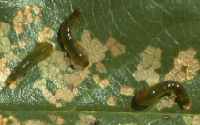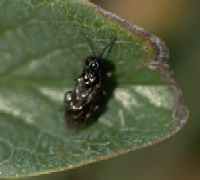by W.S. Cranshaw and D.A. Leatherman* (7/14)
Quick Facts…
- Pear slugs chew the leaves of many common trees and shrubs such as cotoneaster, cherry and related plants.
- Pear slugs are not true slugs. They are a type of insect known as sawflies.
- Two generations of pear slug occur. Most damage usually occurs from the second (September) generation.
- When severe defoliation is threatened, pear slug injury should be controlled.

Figure 1: Pear slug larva on leaf and characteristic feeding injury. |
Pear slugs (often called “cherry slugs”) feed on the leaves of certain commonly planted trees and shrubs during mid- to late summer. Among the more heavily damaged plants in Colorado are cherry, cotoneaster, plum, apricot, pear, hawthorn and mountain ash.
Pear slugs are dark green to orange, swollen at the head end, and slimy. When full-grown, pear slug larvae may reach 1/2 inch. They tend to lighten in color as they grow older. Pear slugs can be confused with common Garden slugs, but they are really insects. They develop into small, dark, nonstinging wasps (sawflies) that are rarely noticed.
History and Damage
Pear slugs pass the winter underground in the pupal stage. During late spring, the adult insects emerge to mate and lay eggs. Adult pear slugs are dark colored, nonstinging wasps approximately 1/4 inch long. They lay eggs in slits made in the leaf.

Figure 2: Adult sawfly. |
Young pear slugs feed on leaves and become full-grown in approximately three weeks. Pear slug larvae feed on the upper leaf surface. They avoid the larger leaf veins and rarely penetrate the lower leaf surface. The resultant “skeletonized” leaves have a characteristic appearance. Chewed areas of the leaf turn brown. When heavily damaged, the entire leaf falls prematurely.
Pear slug injury occurs in two peaks during the growing season. This injury coincides with the presence of full grown larvae, which do most of the feeding. In Colorado, damage by the first generation often peaks in late July. The second generation of larvae are usually most active in September. This later generation is often the most damaging and can completely defoliate susceptible plants.
Control
Severe pear slug injury most often occurs late in the season and has little impact on plant health. However, the damage may be quite unattractive. Occasionally, heavy infestations can reduce plant vigor. In these situations pear slugs may need control.
Most insecticides easily control pear slugs when used at labeled rates listed for control of caterpillars or leaf beetles on trees and shrubs. Among the effective insecticides are carbaryl (Sevin, Sevimol), malathion and Spinosad. Malathion and carbaryl can be used on fruit trees if waiting periods (1 to 14 days) are observed.
Pear slugs often can be controlled using a forceful jet of water to dislodge them. Soaps also have been effective for controlling pear slugs (see fact sheet 5.547, Insect Control: Soaps and Detergents) but can injure plants such as cotoneaster, plum and cherry. Pear slugs are also readily killed by applications of wood ashes.
*W.S. Cranshaw, Colorado State University Extension entomologist and professor, bioagricultural sciences and pest management; and D.A. Leatherman, entomologist, Colorado State Forest Service. 1/92. Revised 7/14.
Go to top of this page.





